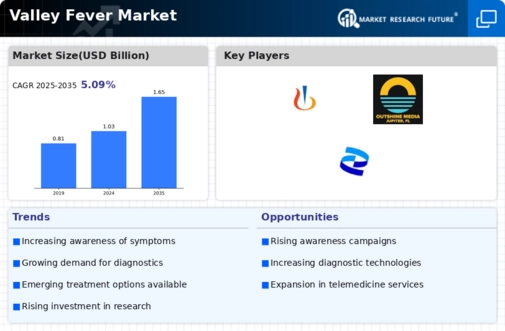Market Growth Projections
Emerging Treatment Options
The development of new treatment options for Valley Fever is a critical factor influencing the Global Valley Fever Market Industry. Recent research has led to the exploration of novel antifungal therapies and combination treatments that may improve efficacy and reduce side effects. As these options become available, they are expected to enhance patient care and drive market growth. The anticipated CAGR of 4.37% from 2025 to 2035 reflects the potential for these emerging therapies to reshape treatment paradigms. The ongoing innovation in this area is crucial for addressing the evolving challenges posed by Valley Fever.
Government Support and Funding
Government initiatives and funding aimed at combating Valley Fever are pivotal drivers of the Global Valley Fever Market Industry. Increased funding for research, public health campaigns, and healthcare infrastructure enhances the capacity to manage and treat the disease effectively. Various state and federal programs focus on improving awareness and developing new treatment options, which could lead to better patient outcomes. This support is likely to stimulate market growth, as evidenced by the projected increase in market value to 1.03 USD Billion in 2024. Such governmental backing is essential for fostering innovation and improving healthcare delivery.
Rising Incidence of Valley Fever
The Global Valley Fever Market Industry is experiencing growth due to the increasing incidence of Valley Fever, particularly in endemic regions such as the Southwestern United States. The disease, caused by the fungus Coccidioides, has seen a rise in reported cases, with thousands diagnosed annually. This uptick in cases necessitates enhanced awareness and treatment options, thereby driving market expansion. As the population in these areas grows, the potential for exposure to the fungus increases, contributing to the overall market growth. The projected market value of 1.03 USD Billion in 2024 underscores the urgency of addressing this public health concern.
Increased Awareness and Education
The Global Valley Fever Market Industry benefits from heightened awareness and educational initiatives aimed at both healthcare professionals and the general public. Campaigns that inform about the symptoms, transmission, and prevention of Valley Fever are crucial in reducing the disease's impact. As awareness grows, more individuals seek medical attention, leading to increased diagnoses and treatment. This trend is expected to contribute to the market's projected value of 1.65 USD Billion by 2035. Enhanced education efforts may also encourage preventive measures, thereby potentially reducing the incidence of the disease over time.
Advancements in Diagnostic Techniques
Technological advancements in diagnostic methods are significantly influencing the Global Valley Fever Market Industry. Improved diagnostic tools, such as serological tests and molecular techniques, enable quicker and more accurate identification of Valley Fever. This not only enhances patient outcomes but also facilitates timely treatment interventions. As healthcare providers adopt these innovative technologies, the market is likely to expand. The anticipated growth trajectory, with a projected CAGR of 4.37% from 2025 to 2035, indicates that the demand for effective diagnostic solutions will continue to rise, further solidifying the market's position.




